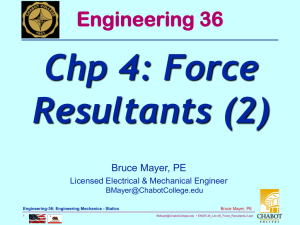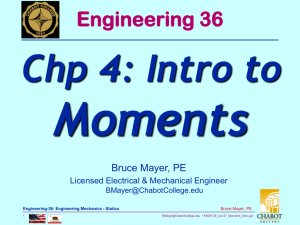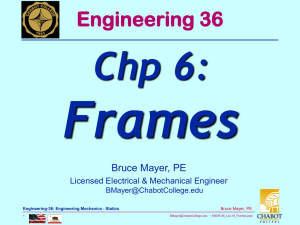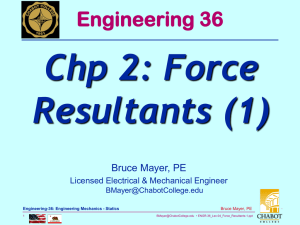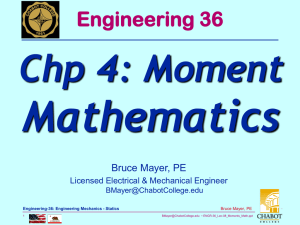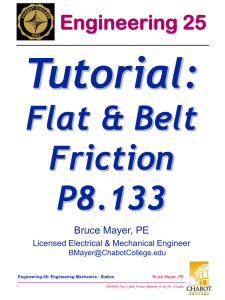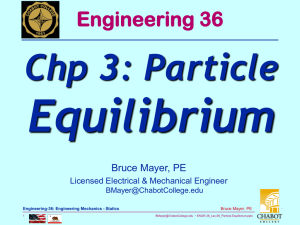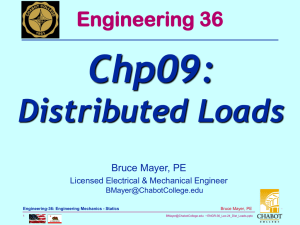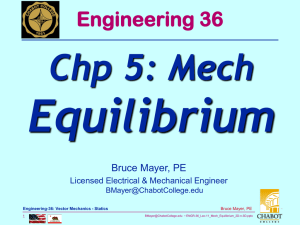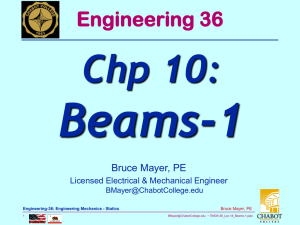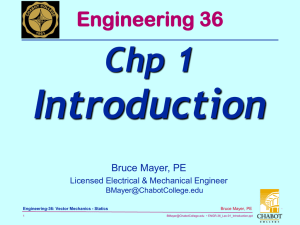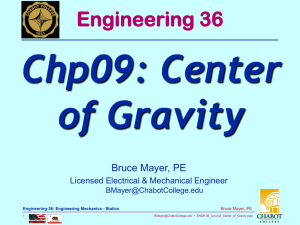ENGR-36_Lec-09_Moments_Equiv
advertisement
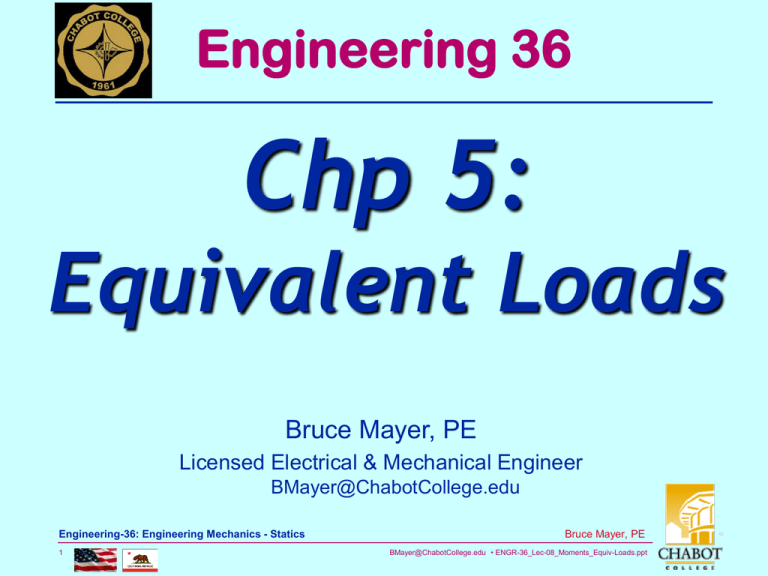
Engineering 36 Chp 5: Equivalent Loads Bruce Mayer, PE Licensed Electrical & Mechanical Engineer BMayer@ChabotCollege.edu Engineering-36: Engineering Mechanics - Statics 1 Bruce Mayer, PE BMayer@ChabotCollege.edu • ENGR-36_Lec-08_Moments_Equiv-Loads.ppt Introduction: Equivalent Loads Any System Of Forces & Moments Acting On A Rigid Body Can Be Replaced By An Equivalent System Consisting of these “Intensities” acting at Single Point: • One FORCE (a.k.a. a Resultant) • One MOMENT (a.k.a. a Couple) Equiv. Sys. Engineering-36: Engineering Mechanics - Statics 2 Bruce Mayer, PE BMayer@ChabotCollege.edu • ENGR-36_Lec-08_Moments_Equiv-Loads.ppt External vs. Internal Forces Two Classes of Forces Act On Rigid Bodies: • External forces • Internal forces The Free-Body Diagram Shows External Forces • UnOpposed External Forces Can Impart Accelerations (Motion) – Translation – Rotation – Both Engineering-36: Engineering Mechanics - Statics 3 Bruce Mayer, PE BMayer@ChabotCollege.edu • ENGR-36_Lec-08_Moments_Equiv-Loads.ppt Transmissibility: Equivalent Forces Principle of Transmissibility • Conditions Of Equilibrium Or Motion Are Not Affected By TRANSMITTING A Force Along Its LINE OF ACTION Note: F & F’ Are Equivalent Forces Moving the point of application of F to the rear bumper does not affect the motion or the other forces acting on the truck Engineering-36: Engineering Mechanics - Statics 4 Bruce Mayer, PE BMayer@ChabotCollege.edu • ENGR-36_Lec-08_Moments_Equiv-Loads.ppt Transmissibility Limitations Principle of transmissibility may not always apply in determining • Internal Forces • Deformations Rigid Deformed TENSION COMPRESSION Engineering-36: Engineering Mechanics - Statics 5 Bruce Mayer, PE BMayer@ChabotCollege.edu • ENGR-36_Lec-08_Moments_Equiv-Loads.ppt Moment of a Couple COUPLE Two Forces F and −F With Same • • • • Magnitude Parallel Lines Of Action Distance separation Opposite Direction Moment of The Couple about O M rA F rB F rA rB F r F M F r sin Fd d the distance Engineering-36: Engineering Mechanics - Statics 6 Bruce Mayer, PE BMayer@ChabotCollege.edu • ENGR-36_Lec-08_Moments_Equiv-Loads.ppt M of a Couple → Free Vector Thus The Moment Vector Of The Couple is INDEPENDENT Of The ORIGIN Of The Coord Axes • Thus it is a FREE VECTOR – i.e., It Can Be Applied At Any Point on a Body With The Same Effect Two Couples Are Equal If • F1d1 = F2d2 • The Couples Lie In Parallel Planes • The Couples Have The Tendency To Cause Rotation In The Same Direction Engineering-36: Engineering Mechanics - Statics 7 Bruce Mayer, PE BMayer@ChabotCollege.edu • ENGR-36_Lec-08_Moments_Equiv-Loads.ppt Some Equivalent Couples These Couples Exert Equal Twist on the Blk For the Lug Wrench Twist • Shorter Wrench with greater Force Would Have the Same Result • Moving Handles to Vertical, With Same Push/Pull Has Same Result Engineering-36: Engineering Mechanics - Statics 8 Bruce Mayer, PE BMayer@ChabotCollege.edu • ENGR-36_Lec-08_Moments_Equiv-Loads.ppt Couple Addition Consider Two Intersecting Planes P1 and P2 With Each Containing a Couple M 1 r F1 in plane P1 M 2 r F2 in plane P2 Resultants Of The Force Vectors Also Form a Couple M r R r F1 F2 Engineering-36: Engineering Mechanics - Statics 9 Bruce Mayer, PE BMayer@ChabotCollege.edu • ENGR-36_Lec-08_Moments_Equiv-Loads.ppt Couple Addition By Varignon’s Distributive Theorem for Vectors M r F1 r F2 M1 M 2 Thus The Sum of Two Couples Is Also A Couple That Is Equal To The Vector Sum Of The Two individual Couples • i.e., Couples Add The Same as Force Vectors Engineering-36: Engineering Mechanics - Statics 10 Bruce Mayer, PE BMayer@ChabotCollege.edu • ENGR-36_Lec-08_Moments_Equiv-Loads.ppt Couples Are Vectors Properties of Couples • A Couple Can Be Represented By A Vector With Magnitude & Direction Equal To The Couple-Moment • Couple Vectors Obey The Law Of Vector Addition • Couple Vectors Are Free Vectors – i.e., The Point Of Application or LoA Is NOT Significant • Couple Vectors May Be Resolved Into Component Vectors Engineering-36: Engineering Mechanics - Statics 11 Bruce Mayer, PE BMayer@ChabotCollege.edu • ENGR-36_Lec-08_Moments_Equiv-Loads.ppt Resolution of a Force Into a Force at O and a Couple Couple r x F Force Vector F Can NOT Be Simply Moved From A To O Without Modifying Its Action On The Body Attaching Equal & Opposite Force Vectors At O Produces NO Net Effect On The Body • But it DOES Produce a Couple The Three Forces In The Middle Diagram May Be Replaced By An Equivalent Force Vector And Couple Vector; i.e., a FORCE-COUPLE SYSTEM Engineering-36: Engineering Mechanics - Statics 12 Bruce Mayer, PE BMayer@ChabotCollege.edu • ENGR-36_Lec-08_Moments_Equiv-Loads.ppt Force-Couple System at O’ Moving F from A To a Different Point O’ Requires Addition of a Different Couple Vector M O' r F The Moments of F about O and O’ are Related By The Vector S That Joins O and O’ M O ' r 'F s r F r F s F M O' M O s F Engineering-36: Engineering Mechanics - Statics 13 Bruce Mayer, PE BMayer@ChabotCollege.edu • ENGR-36_Lec-08_Moments_Equiv-Loads.ppt Force-Couple System at O’ M O' M O s F Moving The Force-couple System From O to O’ Requires The Addition Of The Moment About O’ Generated by the Force At O Engineering-36: Engineering Mechanics - Statics 14 Bruce Mayer, PE BMayer@ChabotCollege.edu • ENGR-36_Lec-08_Moments_Equiv-Loads.ppt Example: Couples Determine The Components Of The Single Couple Equivalent To The Couples Shown Engineering-36: Engineering Mechanics - Statics 15 Solution Plan • Attach Equal And Opposite 20 Lb Forces In The ±x Direction At A, Thereby Producing 3 Couples For Which The Moment Components Are Easily Calculated • Alternatively, Compute The Sum Of The Moments Of The Four Forces About An Arbitrary Single Point. – The Point D Is A Good Choice As Only Two Of The Forces Will Produce Non-zero Moment Contributions Bruce Mayer, PE BMayer@ChabotCollege.edu • ENGR-36_Lec-08_Moments_Equiv-Loads.ppt Example: Couples Attach Equal And Opposite 20 lb Forces In the ±x Direction at A • No Net Change to the Structure Mx Mz My My The Three Couples May Be Represented By 3 Vector Pairs Mz M x 30 lb18 in. 540lb in. M y 20 lb12 in. 240lb in. Mx M z 20 lb9 in. 180lb in. M 540lb in.iˆ 240lb in. ˆj 180lb in.kˆ Engineering-36: Engineering Mechanics - Statics 16 Bruce Mayer, PE BMayer@ChabotCollege.edu • ENGR-36_Lec-08_Moments_Equiv-Loads.ppt Example: Couples rDC rDE Alternatively, Compute The Sum Of The Moments Of The Four Forces About D Only The Forces At C and E Contribute To The Moment About D • i.e., The Position vector, r, for the Forces at D = 0 M M D 18 in. ˆj 30 lbkˆ 9 in. ˆj 12 in.kˆ 20 lbiˆ M 540lb in.iˆ 240lb in. ˆj 180lb in.kˆ Engineering-36: Engineering Mechanics - Statics 17 Bruce Mayer, PE BMayer@ChabotCollege.edu • ENGR-36_Lec-08_Moments_Equiv-Loads.ppt Reduction to Force-Couple Sys A SYSTEM OF FORCES May Be REPLACED By A Collection Of FORCECOUPLE SYSTEMS Acting at Given Point O The Force And Couple Vectors May then Be Combined Into a single Resultant ForceVector and a Resultant Couple-Vector R F Engineering-36: Engineering Mechanics - Statics 18 R MO r F Bruce Mayer, PE BMayer@ChabotCollege.edu • ENGR-36_Lec-08_Moments_Equiv-Loads.ppt Reduction to a Force-Couple Sys The Force-Couple System at O May Be Moved To O’ With The Addition Of The Moment Of R About O’ as before: R R M O' M O s R Two Systems Of Forces Are EQUIVALENT If They Can Be Reduced To The SAME Force-Couple System Engineering-36: Engineering Mechanics - Statics 19 Bruce Mayer, PE BMayer@ChabotCollege.edu • ENGR-36_Lec-08_Moments_Equiv-Loads.ppt More Reduction of Force Systems If the Resultant Force & Couple At O Are Perpendicular, They Can Be Replaced By A Single Force Acting With A New Line Of Action. (a) (b) Force Systems That Can be Reduced to a Single Force a) Concurrent Forces – Generates NO Moment b) Coplanar Forces (next slide) R zR M c) The Forces Are Parallel y x – CoOrds for Vertical Forces Engineering-36: Engineering Mechanics - Statics 20 xRy M zR (c) Bruce Mayer, PE BMayer@ChabotCollege.edu • ENGR-36_Lec-08_Moments_Equiv-Loads.ppt CoPlanar Force Systems System Of CoPlanar Forces Is Reduced To A Force-couple System That Perpendicular Is Mutually R F and M R O r F System Can Be Reduced To a Single Force By Moving The Line Of Action R To Point-A Such That d: d M OR R y0 In Cartesian Coordinates use transmissibility to slide the Force PoA to Points on the X & Axes xRy yRx M Engineering-36: Engineering Mechanics - Statics 21 x0 R O Bruce Mayer, PE BMayer@ChabotCollege.edu • ENGR-36_Lec-08_Moments_Equiv-Loads.ppt Example: 2D Equiv. Sys. Solution Plan a) Compute – – For The Beam, Reduce The System Of Forces Shown To a) An Equivalent ForceCouple System At A b) An Equivalent ForceCouple System At B c) A Single Force applied at the Correct Location . Engineering-36: Engineering Mechanics - Statics 22 The Resultant Force The Resultant Couple About A b) Find An Equivalent Force-couple System at B Based On The Forcecouple System At A c) Determine The Point Of Application For The Resultant Force Such That Its Moment About A Is Equal To The Resultant Couple at A Bruce Mayer, PE BMayer@ChabotCollege.edu • ENGR-36_Lec-08_Moments_Equiv-Loads.ppt Example: 2D Equiv. Sys. - Soln a) Find the resultant force and the resultant couple at A. R F 150 N ˆj 600 N ˆj 100 N ˆj 250 N ˆj R 600 N j Now Calculate the Total Moment About A as Generated by the Individual Forces. R MA r F 1.6 iˆ 600ˆj 2.8 iˆ 100ˆj 4.8 iˆ 250ˆj Engineering-36: Engineering Mechanics - Statics 23 R M A 1880N mkˆ Bruce Mayer, PE BMayer@ChabotCollege.edu • ENGR-36_Lec-08_Moments_Equiv-Loads.ppt Example: 2D Equiv. Sys. - Soln b) Find An Equivalent Forcecouple System At B Based On The Force-couple System at A • The Force Is Unchanged By The Movement Of The Force-Couple System From A to B R 600 N ˆj rBA • The Couple At B Is Equal To The Moment About B Of The Forcecouple System Found At A R R M B M A rBA R 1880N mkˆ 4.8 miˆ 600 N ˆj 1880N mkˆ 2880N mkˆ Engineering-36: Engineering Mechanics - Statics 24 R M B 1000 N mk Bruce Mayer, PE BMayer@ChabotCollege.edu • ENGR-36_Lec-08_Moments_Equiv-Loads.ppt Example: 2D Equiv. Sys. - Soln c) Determine a SINGLE Resultant Force (NO Couple) • • Chk 1000 Nm at B R M B rBx R 3.13 4.8iˆ 600 N ˆj 1.67iˆ 600 N ˆj 1002N m kˆ Engineering-36: Engineering Mechanics - Statics 25 The Force Resultant Remains UNCHANGED from parts a) & b) The Single Force Must Generate the Same Moment About A (or B) as Caused by the Original Force R System M A rAx R 1880N m kˆ xiˆ 600 N ˆj 1880N m kˆ 600x N kˆ Then the Single-Force Resultant R 600 N ˆj x 3.13 m Bruce Mayer, PE BMayer@ChabotCollege.edu • ENGR-36_Lec-08_Moments_Equiv-Loads.ppt Example: 3D Equiv. Sys. Solution Plan: 3 Cables Are Attached To The Bracket As Shown. Replace The Forces With An Equivalent ForceCouple System at A Engineering-36: Engineering Mechanics - Statics 26 • Determine The Relative Position Vectors For The Points Of Application Of The Cable Forces With Respect To A. • Resolve The Forces Into Rectangular Components • Compute The Equivalent Force R F • Calculate The Equivalent Couple R M A r F Bruce Mayer, PE BMayer@ChabotCollege.edu • ENGR-36_Lec-08_Moments_Equiv-Loads.ppt Example Equiv. Sys. - Solution Resolve The Forces Into Rectangular Components FB 700 N uˆ r 75i 150 j 50k uˆ BE rBE 175 Determine The Relative Position Vectors w.r.t. A rAB 0.075i 0.050k m rAC 0.075i 0.050k m rAD 0.100i 0.100 j m Engineering-36: Engineering Mechanics - Statics 27 0.429iˆ 0.857 ˆj 0.289kˆ FB 300iˆ 600 ˆj 200kˆ N FC 1000N cos 45iˆ cos 45kˆ 707iˆ 707kˆ N FD 1200N cos60 iˆ cos30 ˆj 600iˆ 1039ˆj N Bruce Mayer, PE BMayer@ChabotCollege.edu • ENGR-36_Lec-08_Moments_Equiv-Loads.ppt Example Equiv. Sys. - Solution Compute Equivalent Force R F 300 707 600iˆ 600 1039 ˆj 200 707 kˆ R 1607iˆ 439ˆj 507kˆ N Compute Equivalent Couple R MA r F iˆ rAB F B 0.075 300 kˆ ˆj 0.050 30iˆ 45kˆ 0 600 200 iˆ ˆj kˆ 707 0 707 rAC F c 0.075 0 0.050 17.68 ˆj iˆ ˆj kˆ rAD F D 0.100 0.100 0 163.9kˆ 600 1039 0 R M A 30i 17.68 j 118.9k Engineering-36: Engineering Mechanics - Statics 28 Bruce Mayer, PE BMayer@ChabotCollege.edu • ENGR-36_Lec-08_Moments_Equiv-Loads.ppt Distributed Loads The Load on an Object may be Spread out, or Distributed over the surface. Load Profile, w(x) Engineering-36: Engineering Mechanics - Statics 29 Bruce Mayer, PE BMayer@ChabotCollege.edu • ENGR-36_Lec-08_Moments_Equiv-Loads.ppt Distributed Loads If the Load Profile, w(x), is known then the distributed load can be replaced with at POINT Load at a SPECIFIC Location Magnitude of the W w x dx Point Load, W, is span Determined by Area 100 W N Under the 3 Profile Curve Engineering-36: Engineering Mechanics - Statics 30 Bruce Mayer, PE BMayer@ChabotCollege.edu • ENGR-36_Lec-08_Moments_Equiv-Loads.ppt Distributed Loads To Determine the Point Load Location employ Moments Recall: Moment = [LeverArm]•[Intensity] In This Case • LeverArm = The distance from the Baseline Origin, xn • Intensity = The Increment of Load, dWn, which is that load, w(xn) covering a distance dx located at xn – That is: dWn = w(xn)•dx Engineering-36: Engineering Mechanics - Statics 31 Bruce Mayer, PE BMayer@ChabotCollege.edu • ENGR-36_Lec-08_Moments_Equiv-Loads.ppt Distributed Loads Now Use Centroidal Methodology x LeverArm Intensity x wx dx n span And also: x xW span x is theCentroidLocation Equating the Ω Expressions x find Engineering-36: Engineering Mechanics - Statics 32 n x wx dx n n span W Bruce Mayer, PE BMayer@ChabotCollege.edu • ENGR-36_Lec-08_Moments_Equiv-Loads.ppt Distributed Loads on Beams L W wdx dA A 0 OP W xdW L OP A xdA x A 0 • A distributed load is represented by plotting the load per unit length, w (N/m). The total load is equal to the area under the load curve. • A distributed load can be REPLACED by a concentrated load with a magnitude equal to the area under the load curve and a line of action passing through the areal centroid. Engineering-36: Engineering Mechanics - Statics 33 Bruce Mayer, PE BMayer@ChabotCollege.edu • ENGR-36_Lec-08_Moments_Equiv-Loads.ppt Engineering-36: Engineering Mechanics - Statics 34 Bruce Mayer, PE BMayer@ChabotCollege.edu • ENGR-36_Lec-08_Moments_Equiv-Loads.ppt Integration Not Always Needed The Areas & Centroids of Common Shapes Can be found on Inside BackCover of the Text Book Std Areas can be added & subtracted directly Std Centroids can be combined using [LeverArm]∙[Intensity] methods Engineering-36: Engineering Mechanics - Statics 35 Bruce Mayer, PE BMayer@ChabotCollege.edu • ENGR-36_Lec-08_Moments_Equiv-Loads.ppt Example:Trapezoidal Load Profile Solution Plan A beam supports a distributed load as shown. Determine the equivalent concentrated load and its Location on the Beam Engineering-36: Engineering Mechanics - Statics 36 • The magnitude of the concentrated load is equal to the total load (the area under the curve) • The line of action of the concentrated load passes through the centroid of the area under the Load curve. • The Equivalent Causes the SAME Moment about the beam-ends as does the Concentrated Loads Bruce Mayer, PE BMayer@ChabotCollege.edu • ENGR-36_Lec-08_Moments_Equiv-Loads.ppt Example:Trapezoidal Load Profile SOLUTION: • The magnitude of the concentrated load is equal to the total load, or the area under the curve. 1500 4500 N F 6m F 18.0 kN 2 m • The line of action of the concentrated load passes through the area centroid of the curve. 63 kN m X 18 kN Engineering-36: Engineering Mechanics - Statics 37 X 3.5 m Bruce Mayer, PE BMayer@ChabotCollege.edu • ENGR-36_Lec-08_Moments_Equiv-Loads.ppt WhiteBoard Work Let’s Work This Nice Problem For the Loading & Geometry shown Find: • The Equivalent Loading – HINT: Consider the Importance of the Pivot Point • The Scalar component of the Equivalent Moment about line OA Engineering-36: Engineering Mechanics - Statics 38 Bruce Mayer, PE BMayer@ChabotCollege.edu • ENGR-36_Lec-08_Moments_Equiv-Loads.ppt Engineering 36 Appendix Bruce Mayer, PE Licensed Electrical & Mechanical Engineer BMayer@ChabotCollege.edu Engineering-36: Engineering Mechanics - Statics 39 Bruce Mayer, PE BMayer@ChabotCollege.edu • ENGR-36_Lec-08_Moments_Equiv-Loads.ppt
